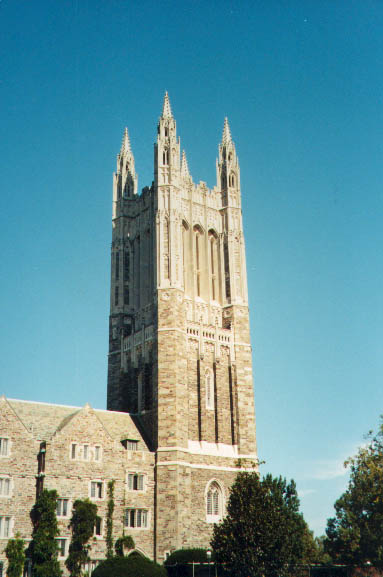Graduate College Tour

The most noticeable feature of the GC is without doubt Cleveland Tower which flanks the entrance to the Graduate College. With its 173-foot height, hundreds of carvings and four outsized turrets it is at once an imposing and a charming presence on the Princeton skyline. Cleveland Tower was built as the national memorial to President Grover Cleveland, who had retired to Princeton and served on the Board of Trustees after his second term in office. In 1926, the Class of 1892 decided to add a carillon to the tower; nowadays, it encompasses 67 bells and is one of the largest in the nation. It is played every Sunday at 1 p.m. except during exam periods.
|

From the top of Cleveland Tower, visitors can take a leisurely survey of the Graduate College. Looking west toward the setting sun, one can see the wing of the Old GC which houses the Common Room, followed by Pyne Tower, which in turn abuts Procter Hall, the great dining hall. Situated behind Procter Hall are Wyman Gardens, designed by Beatrix Farrand, and on the left the Dean's residence, Wyman House.
|

At the foot of the tower looking north-east lies the main courtyard, originally dedicated as Thomson College. The four wings enclosing Thomson College, Cleveland Tower, Pyne Tower, Procter Hall, Wyman House and gardens as well as the kitchen facilities were part of the first phase of construction that was completed in 1913.
|

A second, smaller quadrangle known as the North Court was added in 1927. The New Graduate College, added in 1963, is hidden from view by the summer foliage.
|

Andrew Fleming West's bronze sculpture sits enthroned in the center of a terrace that spans the width of the main quad. Nowadays it is a quiet sunny spot, ideal for reading and contemplation, and hardly a space that reminds the visitor of the epic battles between Dean West and the then University President Woodrow Wilson over the location of the Graduate College.
|

Dean West favored the current location and envisioned graduate education as a quasi monastic scholarly pursuit. President Wilson wanted the Graduate College to be located in the center of campus. Among other reasons, Wilson hoped that graduate students would exert a civilizing influence on the undergraduate student population.
|





